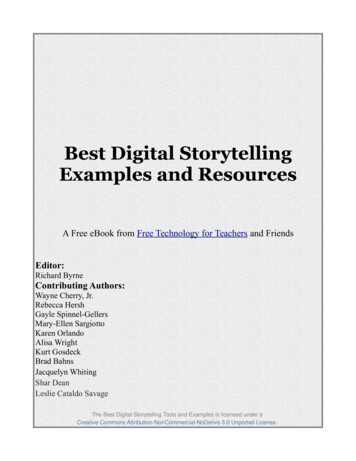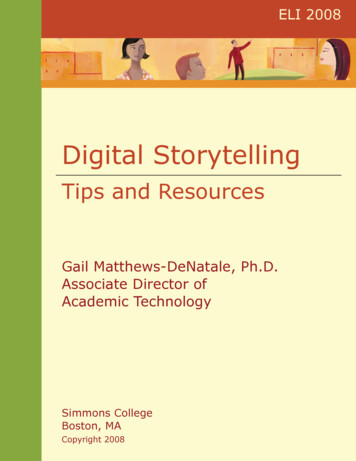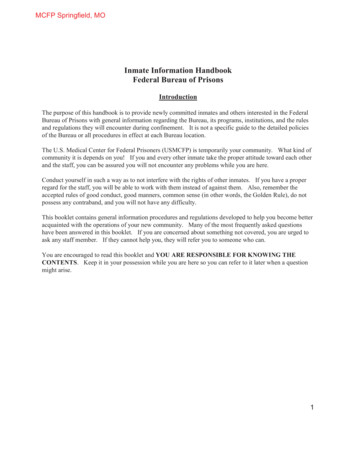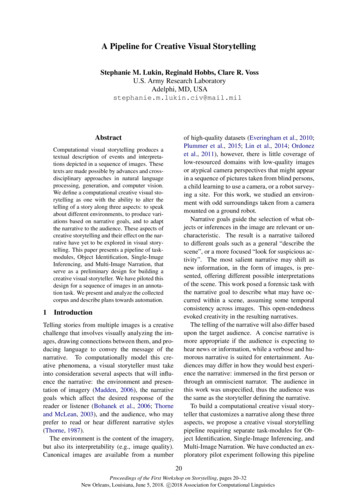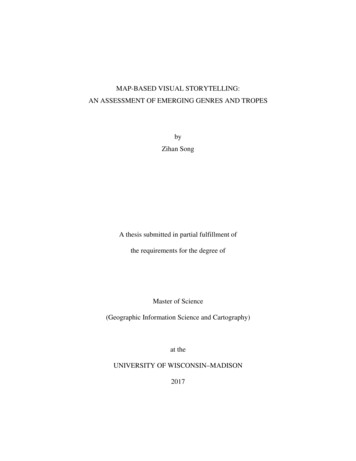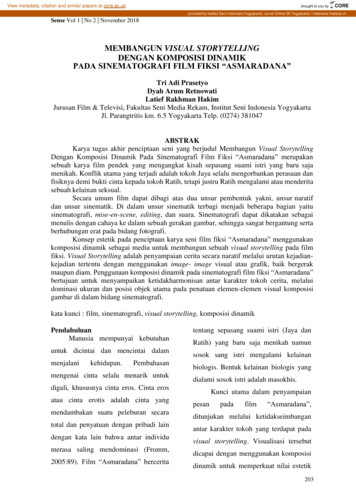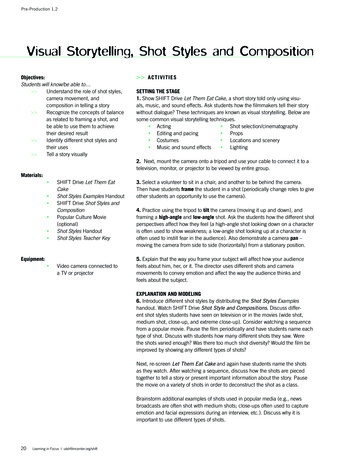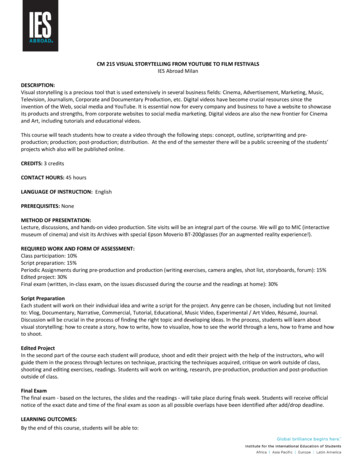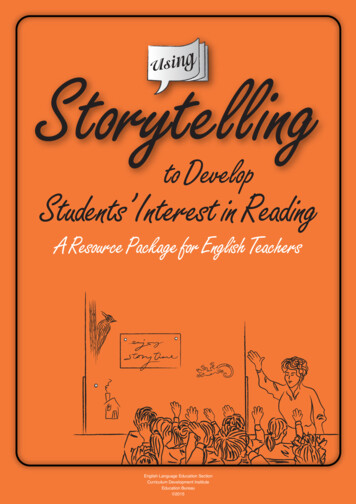
Transcription
Storytellingto DevelopStudents’ Interest in ReadingA Resource Package for English TeachersEnglish Language Education SectionCurriculum Development InstituteEducation Bureau 2015
English Language Education SectionCurriculum Development InstituteEducation BureauThe Hong Kong Special Administrative Region12/F, Wu Chung House, 213 Queen’s Road East, Wan Chai, Hong KongPublished 2015All rights reserved. The copyright of the materials in this resource package belongs to theEducation Bureau of the Hong Kong Special Administrative Region.Duplication of materials in this resource package is restricted to non-profit makingeducational purposes only. Otherwise, no part of these materials may be reproduced, storedin a retrieval system, or transmitted in any form or by any means without the prior permissionof the Education Bureau of the Hong Kong Special Administrative Region.ISBN: 978-988-8159-59-82
ContentsPreface4Part I6IntroductionPart IIUsing Storytelling in the Primary English Classroom10Story 1 The Tailor12Story 2 The Bear Hunt16Story 3 Bali20Story 4 Jack24Story 5 The Road to Lhasa27Story 6 Chalk29AppendixTranscription of the Storytelling Demonstration331
PrefaceUsing Storytelling to Develop Students’ Interest in Reading is a resource package producedby the English Language Education Section, Curriculum Development Institute, the EducationBureau, the Hong Kong Special Administrative Region, in support of the English LanguageCurriculum Guide (Primary 1 – 6) (CDC, 2004). The resource package is based on the professionaldevelopment activity ‘Using Storytelling to Develop Students’ Interest in Reading’ organised inApril 2014. Additional materials and ideas are included for teachers’ reference in using storytellingas a teaching strategy in the primary English classroom.Aims of the Resource PackageThe resource package aims to enhance teachers’ knowledge and skills in conducting storytellingthrough providing: suggestions on how to incorporate storytelling into the primary English classroom; stories and suggested activities; and video clips to demonstrate good storytelling techniques.Contents of the Resource PackageThe resource package comprises a handbook and a DVD-ROM. The handbook contains the following:Part I: IntroductionaWhat is storytelling?aWhy should storytelling be used in the English classroom?aWhat is the role of storytelling in the English Language Curriculum?aHow should storytelling be conducted in the English classroom?Part II: Using Storytelling in the Primary English ClassroomTeachers may consider the features of a text in deciding whether the text could be used toconduct storytelling in the primary English classroom. Six stories (Stories 1 – 6) are included in theresource package to illustrate the different features of texts which are suitable for conductingstorytelling. Some suggested activities to be conducted before, during and after storytellingare provided for teachers’ reference. Only the text version of Stories 1 – 5 is included as Story6 is a picture book.4
Appendix: Transcription of the Storytelling DemonstrationaTranscription of the storytelling demonstration is provided for teachers’ reference. The DVD-ROM contains the following:aAn electronic version of the handbook (in both MS WORD and PDF formats)aSix video clips of the storytelling demonstration5
Part IIntroduction
Part IHow much do you know about storytelling? Try to answer the following questions.QuestionsYesNo(Please put a “3”in the appropriate box.)(a) Is storytelling used only when there is spare time in English lessons?qq(b) Is storytelling only for very young children?qq(c) Is storytelling best conducted by NETs?qq(d) Are story books and big books a must in storytelling?qq(e) Should we teach students to tell stories?qq1. What is storytelling?Storytelling is one of the teaching strategies for reading. It is an effective strategy to hold theattention and concentration span of young, active and restless children. It can stimulateemergent readers’ interest in reading as it provides a good opportunity to develop goodlistening skills and basic reading skills at the same time.2. Why should storytelling be used in the English classroom?Storytelling can provide students of all ages with an enjoyable and relaxing learningexperience. The length of the stories may vary, depending on the lesson time and thepurpose for introducing the stories to the students – for enjoyment and stimulation, developinglanguage skills, teaching the moral, etc. When listening to stories, students can:3listen to and take part in the story;3give expression to their imaginative ideas;3develop skills in listening for explicit and implicit meaning;3respond to imaginative experiences with increasing understanding;3develop positive attitudes and values;3work with narrative texts with teacher support;3read the same texts later with teacher support or on their own; and3become more independent in writing about or describing their own experience.7
Part I3. What is the role of storytelling in the English Language Curriculum?According to the English Language Curriculum Guide (P1-6) (CDC, 2004), schools shoulddevelop students’ reading skills and strategies in both the General English Programmeand Reading Workshops. About 40% of the lesson time could be allocated to the ReadingWorkshops to strengthen the school-based reading programme. Various teaching strategiescould be adopted in the Reading Workshops to enhance students’ reading skills development.Storytelling is one of the teaching strategies to help young students learn and practise the keyskills and apply the reading strategies in learning to read.For details of the teaching strategies for reading, please refer to Appendix 5 of the EnglishLanguage Curriculum Guide (P1-6) (CDC, 2004) which is available at elopment/kla/eng-edu/primary%201 6.pdfFigure 1: Storytelling in the English Language Curriculum4. How should storytelling be conducted in the English Classroom?When conducting storytelling, all English teachers including Native-speaking English Teachers(NETs) can make use of simple language, intonation, facial expressions and appropriategestures, props and pictures to help students understand and interact with the content ofthe stories. The vocabulary in the story can be adjusted in the process of storytelling to suitthe language proficiency of the students. In storytelling, the use of books is not necessary.Teachers can tell stories drawing upon their own experiences to arouse students’ curiosityand sustain their interest.8
Part IStudents’ participation can be enhanced through making group participating actions/sounds.The teacher may encourage students to repeat a phrase, a catchy refrain or a repetitivepattern as well as copy his/her actions. Students may be provided with the opportunities tobecome storytellers themselves, so that they can experiment with the use of facial expressions,gestures and intonation. Students can also be invited to assist in telling the story by being thecharacter(s) in the story. They can also be given lines to say. The class can join in and say thelines of the characters.Below are some suggested steps for teachers to conduct storytelling:Before storytelling Display pictures or real objects and tell students that you are going to tell a story aboutthem. Introduce the setting and characters of the story and invite students to predict what thestory is about.During storytelling Tell the story, and throughout the process take on the roles of the characters and thenarrator by adjusting the intonation, gestures and facial expressions accordingly. Use pictures or relevant props to enhance understanding of the main events or supportingdetails in the story. Invite students to join in at appropriate parts of the story by predicting the next part of thestory or inferring the characters’ intentions and feelings. Invite students to mime the actions/sounds of the characters. Ask stimulating questions to check students’ understanding of the story.After storytelling Invite students to:- sequence some pictures based on the content of the story just told;- act out part of the story, using relevant props to remind them of the content of thestory; and- discuss the events in the story after storytelling. Distribute the text version of the story to students and provide them with the opportunityto read the story with teacher support or on their own.Teach reading skills by exploiting the story.Answers to questions about storytelling on p.7:(a) No; (b) No; (c) No; (d) No; (e) Yes 9
Part IIUsing Storytelling in the PrimaryEnglish Classroom
Part IIThe features of a text should be taken into consideration when deciding whether the textcould be used to conduct storytelling in the primary English classroom. Six stories (Stories 1 –6) are included in the resource package to illustrate the different features of texts which aresuitable for conducting storytelling. They are stories containing a simple and clear storyline,repetitive language patterns and/or being a rhythmic chant. Their language is memorable andpredictable and students can pick up the language more easily. Students may come acrossthe theme of some of these stories in other Key Learning Areas/subjects, which can help topromote reading across the curriculum. The moral of some of the stories can also enhancestudents’ understanding of positive values and attitudes. One of the stories is from a real bookwith pictures only. It can help develop creativity in students.FeatureStorySimple and clear storylineAll six storiesRhythmic chantStory 2 The Bear HuntRepetitive language patternStory 1 The TailorStory 2 The Bear HuntStory 5 The Road to LhasaTheme introduced in other Key LearningStory 3 Bali (General Studies)Areas/subjectsMoral developing positive valuesStory 3 Bali (respect for others, care for others)and attitudesStory 4 Jack (spirit of adventure)Story 5 The Road to Lhasa (perseverance)Picture bookStory 6 ChalkFigure 2: Summary of features of the six stories in the resource packageWith a view to facilitating the use of these stories in English lessons, some suggested activities tobe conducted before and after storytelling are provided for teachers’ reference. Teachers canalso refer to the storytelling demonstration video clips in the DVD-ROM for some ideas aboutthe use of various techniques during storytelling, e.g. ‘draw as you tell’, variation in rhythm andspeed, use of onomatopoeia, repetitive language patterns, intonation, facial expressions,appropriate gestures, props and pictures. Transcription of the storytelling demonstration in theAppendix is provided for teachers’ reference.11
Part IIStory 1 The TailorRoberto was a tailor. He was a very good tailor. He would make the most wonderful suits for menand the most beautiful dresses for women. He would even make clothes for the Queen, operasingers and film stars. But it was so strange that his own clothes were very old and shabby. Hehad patches on his elbows and his knees.And one day, his wife said to him, ‘Roberto, why don’t you make yourself a new suit? Think!What a wonderful advertisement it will be as you walk along the road! People will see, and theywill go to you! And you could say, “Yes, I made it myself!”, and you could give them your namecard.’ ‘No, I don’t want to make myself a new suit until I find a special piece of cloth - a pieceof cloth that is as dark as night, as colourful as the rainbow, as strong as steel and as soft as silk,’said Roberto.When Roberto’s wife heard that, she said, ‘Huh? Are you crazy? Where in Hong Kong canyou find a special piece of cloth? A piece of cloth that is as dark as night, as colourful as therainbow, as strong as steel and as soft as silk.’ Roberto just looked at his wife and shrugged hisshoulders and said, ‘Well, we’ll see ’A few days later, someone knocked on Roberto’s front door. And when he opened it, he saw apostman holding a big parcel. The postman gave Roberto the parcel. When he took his scissorsand opened the parcel, he found a piece of cloth that was as dark as night, as colourful as therainbow, as strong as steel and as soft as silk.‘Now, I am going to make myself a new suit,’ said Roberto. He then took his scissors and cutthe cloth. Snip Snip Snip And he sewed the cloth. Da da da da da da da Da da da da da dada Da da da da da da da And with his needle, he stitched the cloth. Stitch Stitch StitchHe made himself a new suit, and he liked that suit so much. He wore it here; he wore it there;he wore it everywhere! In fact, he wore it so much. The suit wore out. It had holes, holes, holes,holes and holes. He was going to throw it away. When he looked again and saw that there wasenough cloth to make himself a waistcoat. So, he took his scissors, and with his scissors, he cutthe cloth. Snip Snip Snip And he sewed the cloth. Da da da da da da da Da da da da da dada Da da da da da da da And with his needle, he stitched the cloth. Stitch Stitch StitchHe made himself a magnificent waistcoat, and he liked that waistcoat so much. He wore it here;he wore it there; he wore it everywhere until it was worn out, too. It had holes, holes, holes, holes12
Part IIand holes! So he was going to throw it away. But he looked again and he saw that there wasenough cloth to make himself a cap. So he took his scissors and he cut the cloth. Snip Snip SnipAnd he sewed the cloth. Da da da da da da da Da da da da da da da Da da da da da da daAnd with his needle, he stitched the cloth. Stitch Stitch StitchHe made himself a really cool cap, and he liked that cap so much. He wore it here; he wore itthere; he wore it everywhere until it was worn out, too. Holes, holes, holes, holes and holes! Hewas going to throw it away. When he looked again and he saw that there was enough materialto make himself a button. So he took his scissors and he cut the cloth. Snip Snip Snip And hesewed the cloth. Da da da da da da da Da da da da da da da Da da da da da da da And withhis needle, he stitched the cloth. Stitch Stitch StitchHe made himself a wonderful button and he liked that button so much. He wore it here; he woreit there; he wore it everywhere until it was worn out, too. Holes, holes, holes, holes and holes! Hewas just about to throw it away. When he looked again and saw that there was enough clothto make himself a story. So he took his scissors. Because it’s such a small piece of cloth and hecut it with the scissors very carefully. Snip Snip Snip And he sewed the cloth. Da da da da da dada Da da da da da da da Da da da da da da da. And with his needle, he stitched the cloth.Stitch Stitch StitchOUCH! So he made himself a story and he liked that story so much. He told it here; he told itthere; he told it everywhere. BUT because it was a story, it never wore out, and he is telling thatstory to this very day.13
Part IIStory 1 The TailorSuggested activitiesBefore Storytelling Ask students who makes clothes for them (a tailor). Ask students to mime the actions of a tailor in making clothes, i.e. cut the cloth, sew the cloth,stitch the cloth. Write the title of the story on the board and ask students to predict what kinds of clothingitems are made by the tailor in the story.During Storytelling Employ onomatopoeia (i.e. sounds that are similar to the noises the words refer to) andactions to motivate students to participate in storytelling, e.g. Snip Snip Snip (mime cuttingthe cloth with scissors). Capitalise on the repetitive language patterns, e.g. repeated use of sentence structures ‘Hewore it here; he wore it there; he wore it everywhere!’ and repeated use of literary devicessuch as similes ‘A piece of cloth that is as dark as night, as colourful as the rainbow, as strongas steel and as soft as silk.’. Invite students to make prediction on what might happen in the story, e.g. what was insidethe big parcel delivered to the tailor.After Storytelling Distribute the story text to the students.For KS1 students: Read aloud the story (from the beginning to the parcel delivery) with the class. Ask students to read the rest of the story and locate the four clothing items that the tailormade for himself. Guide students to suggest other possible clothing items that the tailor can make. Write down all the clothing items suggested by students on the board.For KS2 students: Invite two students to role play the dialogue between the tailor and his wife.14
Part II Draw students’ attention to the use of similes, e.g. ‘A piece of cloth that is as dark as night, ascolourful as the rainbow, as strong as steel and as soft as silk.’ Ask students to work in groups and give each group a piece of paper and a few markers. Ask each group to write similes to describe some clothing items, e.g. ‘I want to make pajamasfor my mother, I need a piece of cloth that is as bright as the sun.’ Ask the other groups to listen and draw pictures of the clothing items.15
Part IIStory 2 The Bear HuntWe’re going on a bear hunt.We’re going to catch a big one.I’m not scared, I’m not scared!It’s a beautiful day!We come to a fence,A very tall fence.We can’t go over it.We can’t go through it.We’ve got to go under it!Hugggh! Huggghh! Huggghhh!Crawl! Crawl! Crawl! Crawl!We’re going on a bear hunt.We’re going to catch a big one.I’m not scared! Huh!It’s a beautiful day!We come to a bridge,A very long bridge.We can’t go under it.We can’t go through it.We’ve got to go over it!Stomp! Stomp! Stomp! Stomp! Stomp! Stomp! Stomp! Stomp! Hey!We come to some mud,Very sticky mud.We can’t go over it.We can’t go DIG! DIG! under it.We’ve got to go through it!Squish, Squish, Squish! Squish, Squish, Squish! Weeeeeeeeeeee!We come to a hill,A very high hill.We can’t go under it.16
Part IIWe can’t go DIG! DIG! through it.We’ve got to go over it!Huff! Puff! Huff! Puff! Huff! Puff! Huff! Puff!We get to the top.Have you seen the bears yet?NO!Let’s take a rest! Arhhhhhhhhhhh!We run down the other side – da da da da da da da da da daWe come to a river,A very wide river.We can’t go over it.We can’t go BLURP BLURP BLURP BLURP BLURP! under it.We’ve got to go through it!Splish! Splash! Splish! Splash! Splish! Splash!We come to a cave,A dark spooky cave.Something’s dripping,Drip! Drop! Plip! Plop!We’re going on a bear hunt.We’re going to catch a big one.I’m not scared!It’s a beautiful day outside!ARGGHHHHHHHHHHHH!Something’s breathing.Something’s snoring! Zzzz! Phew! Zzzz! Phew! Zzzz! Phew!Reach out your hand.Something’s there!It’s a . BEAR!ARGGHHHHHHHHHHHH!17
Part IIRun from the cave.Down to the river – Splish! Splash! Splish! Splash!Run up the hill – da da da da da da da da daGet to the top.Have you seen the bear yet?IT’S BEHIND US!ARGGHHHHHHHHHHHH!Run down the other side – da da da da da da da da da daRun to the mud – Squish! Squish! Squish! WOW!Run to the bridge – Stomp! Stomp! Stomp! Stomp! Stomp! Stomp! Stomp!Run to the fence – Huggggggghhhhhh!CRAWL! CRAWL! CRAWL! CRAWL!Run all the way home.Open the door! Eggggggg!Run up the stairs – da da da da da da da da da daOH NO! I FORGOT to CLOSE the door! – da da da da da da da da da daSLAMP! ZAP! ZAP! ZAP!CHA! CHA! CHA! CHA! CHA! CHA!I am NEVER going on a bear hunt again!Aaaaaaaaaaaaaaagh!18
Part IIStory 2 The Bear HuntSuggested ActivitiesBefore Storytelling Display the picture of a bear and ask students to share how they will feel/felt when they see/saw a bear. Tell students that you are going to tell them a story about a journey to find a bear and remindthem to pay attention to what the main character did when s/he met the bear.During Storytelling Employ onomatopoeia, e.g. Hugggh, squish, puff, blurp and actions to motivate studentsto participate in storytelling, e.g. ‘We come to a bridge - (Stand up, march and salute) Stomp!Stomp! Stomp! Stomp! Stomp! Stomp! Stomp! Stomp!’ Say one phrase at a time and encourage students to repeat each phrase and copy theaccompanying actions. (Please refer to the storytelling demonstration in the DVD-ROM.) Demonstrate variation in the rhythm and speed in reading aloud. (Please refer to thestorytelling demonstration in the DVD-ROM.) Emphasise and place stress on the adjectives used in the story, e.g. big, tall, long.After Storytelling Distribute the story text to the students.For KS1 students: Read aloud the story with the class. Ask students to work in groups and identify the places mentioned, e.g. a fence, a bridge. Give each group a piece of paper and a few markers. Ask each group to draw picture of one place and write ‘go the ’, e.g.‘go under the fence’. Ask the whole class to tell the story together and hold up their group’s pictures in turns.For KS2 students: Allow time for students to read the story. Ask students to work in groups. Give each group a piece of paper and a few markers. Ask each group to draw the route of the bear hunt journey and design a bear warning signwith one or two suggestions on what to do when they see a wild bear, e.g. Do not feed wildbear!, Do not shout!, and then present the route and the bear warning signs to the class.19
Part IIIn Bali, there is a very special lizard, called gecko. He has a very special cry. Thegecko goes GEC KO, GEC KO. At one night, the Chief of the village wastrying to get to sleep and the gecko was outside his window. It was goingGEC KO, GEC KO.The Chief couldn’t get to sleep because it was making so much noise. He openedhis window and he said, ‘Gecko, would you mind not making all that noise?’ ‘Don’tblame me!’ the gecko said. ‘It’s all because of the fireflies. They go ON OFF, ON OFF.Because the fireflies are flashing their lights, I can’t get to sleep. Please go and tell thefireflies to stop flashing their lights.’ And the Chief said, ‘Okay!’So the next day, the Chief came to the fireflies. He said, ‘Fireflies, you got to stop flashing yourlights.’ The fireflies went ON OFF, ON OFF. ‘Because of you ’ said the Chief, ‘ the gecko goesGEC KO, GEC KO. And I can’t get to sleep.’ The fireflies said, ‘Don’t blame us! It’s all because ofthe woodpecker. The woodpecker goes TAP TAP TAP. He is obviously sending out the warning.Maybe there’s gonna be an earthquake.’ ‘Oh dear!’ the Chief said, ‘I will go and speak to thewoodpecker.’The Chief came to the woodpecker and he said, ‘Woodpecker ’ The woodpecker wentTAP TAP TAP. ‘You got to stop doing that! Because of you, the fireflies go ON OFF, ON OFF, andthe gecko goes GEC KO, GEC KO and I can’t get to sleep.’ ‘Oh dear!’ said the woodpecker,‘Don’t blame me! It’s the frog. I hear the frog going CROAK CROAK. So obviously he is worriedabout something.’ ‘Oh dear!’ the Chief said, ‘I’d better go and find out what is worrying thefrog.’He came to the frog and said, ‘Frog ’ The frog went CROAK. ‘You got to stop doing that!’ Andthe frog said, ‘Why?’ The Chief said, ‘Because of you, the woodpecker goes TAP TAP TAP andthe fireflies go ON OFF, ON OFF and the gecko goes GEC KO, GEC KO and I can’t get tosleep.’ ‘Oh dear!’ said the frog, ‘Don’t blame me! It’s the dung beetle. Every day, I see the dungbeetle rolling together big balls of poo poo. He rolls it along the street. Isn’t it dirty?’ And theChief said, ‘It certainly is. You carry on going on CROAK. I will go to speak to the dung beetle.’When he came to the dung beetle, he saw it going HURRRR! PEW! HURRRR! PEW! He said, ‘You gotto stop doing that! Because of you, the frog goes CROAK. The woodpecker goes TAP TAP TAP,and the fireflies go ON OFF, ON OFF and the gecko goes GEC KO, GEC KO and I can’t getto sleep.’ The dung beetle said, ‘Don’t blame me! It’s not my poo poo. No! It belongs to the20
Part IIwater buffalo. Every day, I see the water buffalo come home and it drops its poo poo SPLAT!.right there on the street. Isn’t that dirty? So I come along, and I clean it up.’ ‘Oh!’ said the Chief,‘That’s very good of you. Well done! I am going to speak to the water buffalo.’The Chief came to the water buffalo and said, ‘Hey! Water buffalo ’ The water buffalo wentSPLAT! ‘Hey! Be careful! Could you stop dropping your poo poo on the street? Because of you,the dung beetle goes HURRRR! PEW! The frog goes CROAK. The woodpecker goes TAP TAP TAP,and the fireflies go ON OFF, ON OFF and the gecko goes GEC KO, GEC KO and I can’t getto sleep. The water buffalo said, ‘Oh! Don’t blame me! No. It’s the rain.’ ‘The rain?’ asked theChief. ‘Yes!’ answered the water buffalo. ‘Every afternoon, the rain comes down so hard that itknocks the stones out of the way. It leaves big holes, potholes in the ground. So when we comealong, we drop our poo poo. SPLAT! And we fill up the holes. Isn’t it better that people put theirfoot in the poo poo but not in a hole? If they put it in the hole, they might trip up. They mightbreak their ankle.’ And the Chief said, ‘You know, water buffalo, that’s very good! Ok, you keepdropping your poo poo. SPLAT! But not on me!’That night, the Chief was trying to get to sleep. But, outside his window, therewas the GEC KO, GEC KO. ‘Gecko, would you mind not making that soundoutside my window? I can’t get to sleep,’ said the Chief. The gecko said, ‘Ithought you are going to tell the fireflies to stop flashing their lights.’ The Chief thentold the gecko all about the fireflies, the woodpecker, the frog, the dung beetle andthe water buffalo. ‘I don’t want to know about that!’ the gecko said. ‘If it is the rainthat causes the trouble, tell the rain to stop raining!’The next day, the Chief set off. ‘How can I stop the rain from raining? I know. I am going to climbthe highest mountain in Bali.’ He started to climb up the mountain. WOW! It was hot and hardwork. He stopped halfway up and looked around. He saw how beautiful Bali is. He saw the forestwith all its trees. He saw the rivers and the lakes. He saw the women. And they all stood in a longline, carrying their fruits and their flowers to the temple because they want to make offerings totheir god. And he thought that Bali was very beautiful. Why? Because of all the rain. If there wasno rain, there would be no trees. No rain, no rivers. No water, no fruits, no flowers. ‘But what tosay to gecko?’ That night again, the Chief was trying to sleep and again outside his window GEC KO, GEC KO ‘Gecko, would you please stop making that sound?’ And the gecko said,‘But I thought you’re going to get to stop the rain from raining.’ And the Chief said, ‘But if it stopsraining, there will be no puddles.’ And the gecko said, ‘So? Who needs puddles?’ And the Chiefsaid, ‘Well, mosquitoes. Because that’s where mosquitoes breed.’ And the gecko said, ‘EWW!21
Part IIWho needs mosquitoes?’ And the Chief said, ‘You do because that’s what you eat.’ And thegecko said, ‘Oh yeah!’ The Chief said, ‘If there’s no rain, there’ll be no puddles. No puddles, nomosquitoes. So everything ’ said the Chief, ‘ is connected. We all need one another.’And that is why when you go to Bali on holiday, you will still see the rain come down everyafternoon. It rains a lot in Bali. You’ll see the water buffaloes drop their poo poo. SPLAT! You may,if you look very carefully, see the dung beetles HURRRR! PEW! You will certainly hear the frogs goCROAK. You will probably hear the woodpeckers go TAP TAP TAP. If you are lucky, you will seethe fireflies go ON OFF, ON OFF. And you will probably hear the gecko cry GEC KO, GEC KO.But now this particular gecko has moved away from the Chief’s window and he makes his crymuch more softly. GEC KO22
Part IIStory 3 BaliSuggested ActivitiesBefore Storytelling Use a world map to show students the geographical location of Bali. Give some brief information about Bali or invite students to share what they know about Bali. Tell students that it rains a lot in Bali and ask them to guess why. Tell students that they are going to listen to a story which explains it.During Storytelling Employ onomatopoeia and actions to motivate students to participate in storytelling, e.g.GEC KO, TAP TAP TAP. (Please refer to the storytelling demonstration in the DVD- ROM.) Use picture cards of animals to enhance students’ understanding of the characters. Select some students to role play the characters and mime their actions in the story.After Storytelling Distribute the story text to the students.For KS1 students: Choose a few dialogues said by the main characters from the story. Print the dialogues out and cut them into strips. Ask students to work in groups and arrange the dialogues according to the sequence of thestory plot. Ask the class to read aloud the story.For KS2 students: Allow time for students to read the story ‘Bali’. Discuss the moral of the story by identifying the key sentence from the story (i.e. Everything isconnected). Ask students to illustrate it with other examples, e.g. ‘We hate walking because it makes ushot. In fact, walking and sweating is good for health.’23
Part IIStory 4 JackOne day Jack went to stay with his grandpa, who lives in a village in the New Territories. Hisgrandpa was very old and he went to bed very early. Because the village was far away fromthe city, there was no wi-fi and Jack couldn’t use his mobile phone there. Jack thought, ‘Oh no!What am I gonna do?’ Grandpa liked reading books very much and he had a big library. SoJack went to the library and he chose a book from the bookshelf. When he brought the bookdown, a piece of paper fell from the book. Jack, being a curious boy, picked it up.On the piece of paper, he saw that there was a river. He looked again and he saw that there wasalso a lake. And he looked again and he saw mountains marked on the paper. And suddenlyJack said, ‘Oh! I know where this is! That river is the one that goes in front of grandpa’s house.That lake is just down the road, a couple of kilometres away. And I can see those mountainsfrom my bedroom window on the second floor.’ Jack looked at the map again and suddenlyhe saw that there was a cross marked on the map. He said, ‘Oh no! T
(b) Is storytelling only for very young children? q q (c) Is storytelling best conducted by NETs? q q (d) Are story books and big books a must in storytelling? q q (e) Should we teach students to tell stories? q q 1. What is storytelling? Storytelling is one of the teaching strate


